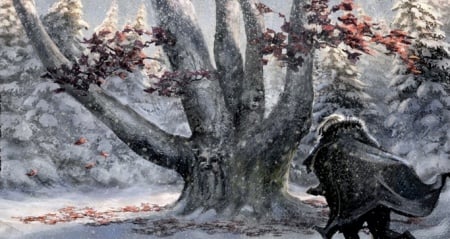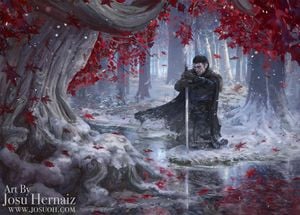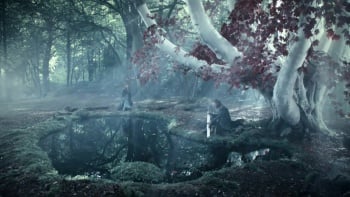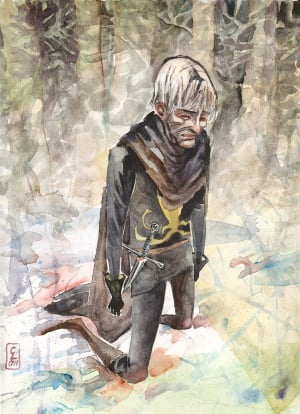Old gods
The old gods are nameless deities[1] of stream, forest, and stone[2] worshiped in the Seven Kingdoms of Westeros and beyond the Wall. They are so named because the Faith of the Seven (the "new gods") replaced them in all but the north of Westeros, where worship of the old gods is still practiced by northmen, crannogmen, and free folk. Westerosi of various faiths commonly swear by the old gods and the new.[3][4][5][6][7][8]
Contents
The old gods
The old gods are nameless and numerous.[9] The free folk who live beyond the Wall believe that the gods are everywhere—in the rocks, streams, birds, and beasts—and that they take the deceased down into the earth and trees.[10] The maesters teach that the weirwoods are sacred to the old gods.[11] However, worshippers believe the old gods watch through the trees.[12][13] It is said that the old gods only have power where the heart tree faces can see, and since the destruction of most of the heart trees in the south they have no power there.[13]
It is said that the sigh of the wind and the rustle of leaves are the old gods speaking back to worshippers.[14] According to Jojen Reed, the singers of the children believe that the weirwood trees are the gods, and that when they die, they become part of the godhood.[11]
Worshippers of the old gods believe that no man can tell a lie in front of a heart tree, as the old gods know when men are telling a lie.[15] Through the eyes of the weirwoods, the old gods judge the people in front of them.[10] As such, an oath might be made in front of a weirwood tree,[16] or with a hand placed in the mouth of the weirwood’s face.[17] It is said that the children of the forest carved faces in the trees during the dawn, centuries before the coming of the First Men from across the narrow sea.[18] According to Maester Luwin, the faces were carved by the greenseers to keep watch on the woods.[19] The First Men believed that the greenseers could see through the eyes of the weirwoods.[20]
The old gods were worshipped by the children of the forest, and eventually after the Pact, by the First Men.[19] Following the coming of the Andals, who brought the Faith of the Seven, the old gods were no longer dominantly worshipped in the south of Westeros.[19] Only a few houses (e.g., House Blackwood)[21] still do, while most of the noble houses follow the Faith of the Seven instead. In the north, however, the majority of the houses still worships the old gods. In the northern lands beyond the Wall, the free folk continue to worship the old gods. Although some accounts state that there are clans who worship different gods (dark gods beneath the ground in the Frostfangs, gods of snow and ice on the Frozen Shore, or crab gods at Storrold's Point), there is no reliable confirmation.[22]
Practices
Various actions, such as incest,[23] slavery,[24] and kinslaying[25] are considered offensive to the old gods, although, as regards kinslaying, the degree of kin and circumstance of killing one’s kin (e.g., in war) hold significant influence.[26] The laws of hospitality are considered to be sacred.[27] It is believed that the old gods can detect when men lie to heart trees.[15]
Worship
Worshippers visit godswoods, groves contained within castles throughout the Seven Kingdoms, where a heart tree can be found. These trees, which have faces carved into them, are considered to be sacred. The heart trees are usually weirwoods, and godswoods are often the only places where living weirwoods still remain[18] until one goes north of the Wall.[12] Once all noble houses had a godswood with a heart tree in its center; However, the First Men, in their wars against the children of the forest, cut down many of the trees, as did the Andals later on, replacing the old gods with their own in the southern kingdoms.[19] Although godswoods can still be found in the south, they now serve as secular gardens.[18]
Prayer[4] and marriages[28] are done in front of a heart tree. The weirwoods and the places they stand are considered to be sacred. They are not to be defiled by bringing animals such as horses into them.[12]
There are no priests, no holy texts, no songs of worship, and practically no rites that go with the worship of the old gods.[1][29] It is a folk religion, passed from generation to generation. Worshipers believe the old gods watch through the trees,[12][13] and prayers are done in silence.[29]
Blood sacrifice was performed in the past.[2][30] For example, the entrails and bodies of criminals and traitors could be hung from the branches of weirwoods after their executions.[31]
Marriage customs
A marriage ceremony takes place in front of a heart tree.[32] The bride's father, or the person standing in his place (usually kin or whoever else is closest to living kin), will escort the bride to her future husband and those presiding over the marriage.[28] Thus far, all the wedding gowns that have thus far been described for a follower of the old gods have been a shade of white.[N 1]
Marriage ceremonies are rather short and contain no priests. The bride is escorted to her groom, who awaits her in front of the weirwood tree in the godswood, and a ceremonial conversation follows, where the identity of the bride, of the groom, and of the person giving the bride away are established. The bride is asked to accept her husband, and upon her agreement ("I take this man") bride and groom join hands, kneel before the heart tree, and bow their heads in token of submission. When they rise following a moment of silent prayer, the groom removes the maiden’s cloak, and places the bride’s cloak around her shoulders, after which he will carry her to the feast in his arms.[28] The wedding ceremony is followed by a feast, which in turn is followed by the bedding.[28][33]
Marriage vows said at swordpoint are not held to be valid, but even if the marriage occurred under force, a lord might claim the marriage to be legal if e.g. lands are at stake.[34]
Lords in Westeros once had the right to the first night, the custom of bedding newly-wed women before their husbands. Queen Alysanne convinced King Jaehaerys I to abolish it,[35][36] but it is still practiced illegally in some parts of the north, as "where the old gods rule, old customs linger".[37]
Funeral customs
Specific funeral customs are not known. However, nobles houses appear to bury deceased family members in crypts beneath their castles. The Starks of Winterfell, traditionally worshippers of the old gods,[13][38][1][39] buries deceased family members in the crypts below Winterfell.[40][41] According to Roose Bolton, another worshipper of the old gods, the bones of his deceased son Domeric “lie beneath the Dreadfort with the bones of his brothers”,[37] suggesting it to be a custom (at least of the nobility).
History
Ancient History
The old gods were originally worshiped by the children of the forest in most of Westeros in the Dawn Age, thousands of years before the arrival of the First Men from Essos via the Arm of Dorne. The First Men warred with the children and, believing that the greenseers of the children could see through the eyes of the weirwoods,[20] cut down the weirwoods where they found them.[19] The children at Moat Cailin are said to have called upon their nameless gods to use the hammer of the waters,[42] and other tales say they performed blood sacrifice at the Isle of Faces.[43]
In time, however, the First Men made peace with the children at the Isle of Faces within the Gods Eye, agreeing to the Pact. In time, they adopted the gods of the children as their own.[19] Other religions of the First Men included the Lady of the Waves and the Lord of the Skies, worshiped on the Three Sisters,[44] and the Drowned God, which is still worshiped on the Iron Islands.[45]
When Corlos spared lion cubs within Casterly Rock, the old gods are said to have rewarded him by revealing gold in Casterly Rock.[46] According to Archmaester Eyron, the crannogmen often thought their Marsh Kings were touched by the old gods.[47]
Arrival of the Andals
Worship of the old gods remained strong across Westeros until the coming of the Andals, with the Andals bringing their Faith of the Seven with them from Andalos. The Andals gradually conquered the south of Westeros.[19] Seeing the old gods as little more than demons, the Andals destroyed the great white trees wherever they found them.[48] Almost all weirwoods in the south were cut down, and the worship of the old gods was supplanted with the gods of the Andals.[19] House Blackwood in the riverlands serves as an exception.[49] The old gods are still worshipped in the north, however, and by the free folk living beyond the Wall.[33] Some clans of the free folk are said to worship different deities than the old gods, however.[22]
Recent History
Humfrey I Teague, King of the Rivers and the Hills, attempted to suppress worship of the old gods in the riverlands, resulting in the downfall of House Teague and control of the riverlands by House Durrandon.[48]
After the Hour of the Wolf many northern men stayed in the south. Hundreds married widows who had lost husbands in the Dance of the Dragons, returning worship of the old gods to many places.[50]
During the tourney at Harrenhal, a crannogman prayed to the old gods of north and Neck.[24] During the tourney, the Knight of the Laughing Tree used a shield decorated with a heart tree of the old gods.[24]
Recent Events
A Game of Thrones
Lord Eddard Stark visits the godswood of Winterfell after the execution of Gared.[18]
Although raised in the Faith of the Seven, Samwell Tarly decides to swear the vows of the Night's Watch at a weirwood grove north of the Wall, rather than at the sept of Castle Black.[12]
Bran Stark prays at Winterfell's godswood for the success of his brother Robb in southern Westeros, but Osha warns that the old gods now only have power in the north.[13]
Within the Red Keep, Sansa Stark prays to the old gods in the castle's godswood and to the new gods of the Seven in the sept.[38]
A Clash of Kings
According to Lord Jon Umber, the red comet is a sign of vengeance from the old gods for the execution of Lord Eddard.[51] The Greatjon also believes that the old gods sent direwolves to Ned's children.[52]
Survivors of the Battle of Oxcross claim that Robb is marching with the support of the old gods of the north.[53]
Arya Stark prays to the old gods within the godswood of Harrenhal.[17]
A Storm of Swords
During the retreat toward Craster's Keep after the fight at the Fist, Samwell prays to any god who will listen.[54] After the mutiny at Craster's Keep, Sam prays before a weirwood in an abandoned wildling village.[55]
When the brotherhood without banners visits the ghost of High Heart, the dwarf woman claims the stirring old gods will not let her sleep.[56]
Stannis Baratheon offers to legitimize Jon Snow after the battle beneath the Wall and name him Lord of Winterfell. Jon decides to refuse, however, since Melisandre would require the burning of the castle's godswood.[57] Because Ghost's white fur and red eyes are reminiscent of weirwoods, Jon thinks his direwolf also belongs to the old gods.[57]
A Feast for Crows
Arya refuses to dispose of Needle in Braavos, believing that the olds gods want her to keep Jon's gift.[58]
A Dance with Dragons
Melisandre requires that submitting free folk burn weirwood branches to symbolize their acceptance of R'hllor.[59] Some of the wildlings continue to carve faces on trees south of the Wall, however.[60]
Ser Bartimus admits that although he is a knight, he still follows the old gods.[30]
Bran learns from the three-eyed crow and children of the forest in a cave beyond the Wall. Greenseers rest within the roots of weirwoods.[61][11]
Lord Roose Bolton announces to his bannermen at Winterfell that the old gods will destroy Stannis with a blizzard for his worship of R'hllor.[62] Queen's men in Stannis's army want to burn sacrifices to R'hllor to end the storm.[63] Theon Greyjoy prays to the old gods in Winterfell's godswood.[64]
Quotes
For her sake, Ned had built a small sept where she might sing to the seven faces of god, but the blood of the First Men still flowed in the veins of the Starks, and his own gods were the old ones, the nameless, faceless gods of the greenwood they shared with the vanished children of the forest.[18]
—thoughts of Catelyn Stark
Castle Black had no godswood, only a small sept and a drunken septon, but Jon could not find it in him to pray to any gods, old or new. If they were real, he thought, they were as cruel and implacable as winter.[65]
—thoughts of Jon Snow
Slight as they were, the children were quick and graceful. Male and female hunted together, with weirwood bows and flying snares. Their gods were the gods of the forest, stream, and stone, the old gods whose names are secret.[19]
—Luwin to Bran Stark
I see you talking to the heart tree. Might be the gods are trying to talk back.[66]
—Osha to Bran Stark
The Mother was merciful, all the septons agreed, but the Seven had no power beyond the Wall. This was where the old gods ruled, the nameless gods of the trees and the wolves and the snows.[54]
—thoughts of Samwell Tarly
Tyrion: I confess, I know little of the old gods. Perhaps someday you might enlighten me. I could even accompany you.
Sansa: No. You ... you are kind to offer, but ... there are no devotions, my lord. No priests or songs or candles. Only trees, and silent prayer.[29]
The maesters will tell you that King Jaehaerys abolished the lord's right to the first night to appease his shrewish queen, but where the old gods rule, old customs linger.[67]
Bran: What do the trees remember?
Jojen: The secrets of the old gods. Truths the First Men knew, forgotten now in Winterfell ... but not in the wet wild. We live closer to the green in our bogs and crannogs, and we remember. Earth and water, soil and stone, oaks and elms and willows, they were here before us all and will still remain when we are gone.[11]—Bran Stark and Jojen Reed
Behind the Scenes
According to George R. R. Martin, the old gods are "based on animism and traditional Pagan beliefs of Wicca and various other Celtic systems and Norse systems", melded into one construct.[68] Martin has also stated that druidism and primitive religions are influences.[69]
Notes
- ↑ Though her ceremony is done following the customs of the Seven, Sansa Stark, a worshipper of both the old gods and the new, wears a gown of ivory samite when she weds Tyrion Lannister in A Storm of Swords, Sansa III. Jeyne Poole, during her ceremony following the customs of the old gods, wears white lambs-wool when she weds Ramsay Bolton in A Dance with Dragons, The Prince of Winterfell.
References
- ↑ 1.0 1.1 1.2 A Game of Thrones, Chapter 70, Jon IX.
- ↑ 2.0 2.1 The World of Ice & Fire, Ancient History: The Dawn Age.
- ↑ A Game of Thrones, Chapter 35, Eddard IX.
- ↑ 4.0 4.1 A Game of Thrones, Chapter 47, Eddard XIII.
- ↑ A Clash of Kings, Chapter 10, Davos I.
- ↑ A Clash of Kings, Chapter 22, Catelyn II.
- ↑ A Dance with Dragons, Chapter 58, Jon XII.
- ↑ The Hedge Knight.
- ↑ So Spake Martin: Gods of Westeros, November 18, 1998
- ↑ 10.0 10.1 A Dance with Dragons, Prologue.
- ↑ 11.0 11.1 11.2 11.3 A Dance with Dragons, Chapter 34, Bran III.
- ↑ 12.0 12.1 12.2 12.3 12.4 A Game of Thrones, Chapter 48, Jon VI.
- ↑ 13.0 13.1 13.2 13.3 13.4 A Game of Thrones, Chapter 53, Bran VI.
- ↑ Many Gods & Dark Faiths article by Ran and Linda
- ↑ 15.0 15.1 A Clash of Kings, Chapter 13, Jon II.
- ↑ A Dance with Dragons, Chapter 17, Jon IV.
- ↑ 17.0 17.1 A Clash of Kings, Chapter 47, Arya IX.
- ↑ 18.0 18.1 18.2 18.3 18.4 A Game of Thrones, Chapter 2, Catelyn I.
- ↑ 19.0 19.1 19.2 19.3 19.4 19.5 19.6 19.7 19.8 A Game of Thrones, Chapter 66, Bran VII.
- ↑ 20.0 20.1 A Clash of Kings, Chapter 28, Bran IV.
- ↑ So Spake Martin: The Faith of the Blackwoods, August 12, 2003
- ↑ 22.0 22.1 The World of Ice & Fire, The Wall and Beyond: The Wildlings.
- ↑ A Clash of Kings, Chapter 33, Catelyn IV.
- ↑ 24.0 24.1 24.2 A Storm of Swords, Chapter 24, Bran II.
- ↑ A Clash of Kings, Chapter 52, Sansa IV.
- ↑ So Spake Martin: Kinslaying In Westeros, May 22, 2001
- ↑ A Storm of Swords, Chapter 57, Daenerys V.
- ↑ 28.0 28.1 28.2 28.3 A Dance with Dragons, Chapter 37, The Prince of Winterfell.
- ↑ 29.0 29.1 29.2 A Storm of Swords, Chapter 53, Tyrion VI.
- ↑ 30.0 30.1 A Dance with Dragons, Chapter 29, Davos IV.
- ↑ The World of Ice & Fire, The North.
- ↑ A Clash of Kings, Chapter 34, Jon IV.
- ↑ 33.0 33.1 A Dance with Dragons, Chapter 49, Jon X.
- ↑ A Clash of Kings, Chapter 35, Bran V.
- ↑ The Sworn Sword.
- ↑ A Dance with Dragons, Chapter 43, Daenerys VII.
- ↑ 37.0 37.1 A Dance with Dragons, Chapter 32, Reek III.
- ↑ 38.0 38.1 A Game of Thrones, Chapter 57, Sansa V.
- ↑ A Clash of Kings, Chapter 43, Jon V.
- ↑ A Clash of Kings, Chapter 69, Bran VII.
- ↑ A Game of Thrones, Chapter 50, Arya IV.
- ↑ A Game of Thrones, Chapter 56, Tyrion VII.
- ↑ The World of Ice & Fire, Dorne: The Breaking.
- ↑ A Dance with Dragons, Chapter 9, Davos I.
- ↑ The World of Ice & Fire, The Iron Islands.
- ↑ The World of Ice & Fire, The Westerlands.
- ↑ The World of Ice & Fire, The North: The Crannogmen of the Neck.
- ↑ 48.0 48.1 The World of Ice & Fire, The Riverlands.
- ↑ A Dance with Dragons, Chapter 48, Jaime I.
- ↑ Fire & Blood, Under the Regents — The Hooded Hand.
- ↑ A Clash of Kings, Chapter 7, Catelyn I.
- ↑ A Clash of Kings, Chapter 39, Catelyn V.
- ↑ A Clash of Kings, Chapter 32, Sansa III.
- ↑ 54.0 54.1 A Storm of Swords, Chapter 18, Samwell I.
- ↑ A Storm of Swords, Chapter 46, Samwell III.
- ↑ A Storm of Swords, Chapter 22, Arya IV.
- ↑ 57.0 57.1 A Storm of Swords, Chapter 79, Jon XII.
- ↑ A Feast for Crows, Chapter 22, Arya II.
- ↑ A Dance with Dragons, Chapter 10, Jon III.
- ↑ A Dance with Dragons, Chapter 21, Jon V.
- ↑ A Dance with Dragons, Chapter 13, Bran II.
- ↑ A Dance with Dragons, Chapter 41, The Turncloak.
- ↑ A Dance with Dragons, Chapter 42, The King's Prize.
- ↑ A Dance with Dragons, Chapter 46, A Ghost in Winterfell.
- ↑ A Game of Thrones, Chapter 19, Jon III.
- ↑ A Clash of Kings, Chapter 4, Bran I.
- ↑ A Dance with Dragons, Chapter 20, Reek II.
- ↑ George R.R. Martin | Talks at Google, August 6, 2011
- ↑ George R R Martin visiting SF-Bokhandeln, June 23, 2015




